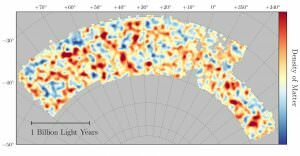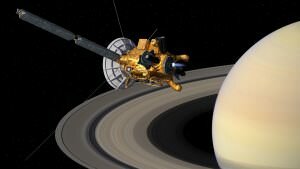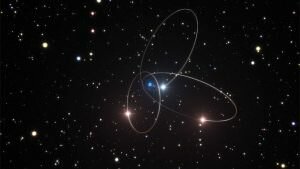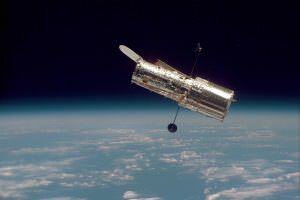Last updated August 21, 2017 at 10:46 am
Find out what the universe delivered in the latest astronomy and astrophysics news with Starstuff every fortnight.
Dark Matter mapped
Dark matter is notoriously difficult to study. We’ve never observed it, but have observed its effects. We know it makes up around a quarter of the mass of the universe, but have never sampled it. And we know it’s everywhere, but have never located it.
 Now Australian scientists have been part of a 400 strong team from around the world to create the most accurate measurement and map of dark matter in the universe. “The survey supports the view that dark matter and dark energy make up most of the cosmos,” said University of Queensland cosmologist Dr Tamara Davis of the 5 year project.
Now Australian scientists have been part of a 400 strong team from around the world to create the most accurate measurement and map of dark matter in the universe. “The survey supports the view that dark matter and dark energy make up most of the cosmos,” said University of Queensland cosmologist Dr Tamara Davis of the 5 year project.
The Dark Energy Survey created a distribution map of dark matter in the cosmos by accurately measuring the position of galaxies. They then accurately measured the shape of 26 million galaxies using new techniques to detect and measure gravitational lensing – an effect when the gravity caused by mass bends light. This allowed them to detect the amount and “clumpiness” of dark matter based on how much gravitational lensing was occurring between the galaxy being observed and Earth – the more distortion of the shape of the galaxy, the more dark matter that was bending the light.
Not only is it the most accurate and largest measurement of dark matter, but it is also the first to measure dark matter in the universe as it is today. Previous measurements have been inferred from observations of the cosmic background radiation left over from the universe during its infancy. However combining the different data sources allows researchers to see the evolution of dark matter in the universe, and they found that it confirmed many predictions that had been previously made.
The results released are based only on the first year of data collected, representing around one thirtieth of the sky. After analysing all 5 years of data, the group will have mapped around one eighth of the sky up to eight billion light years away from Earth.
Dark matter map courtesy of Chihway Chang, University of Chicago and the DES collaboration
Cassini’s final orbits
The Saturn-investigating probe Cassini is preparing for its final orbits this week. Launched nearly 20 years ago and orbiting Saturn for 13 of those, Cassini is reaching the final weeks of its life but is saving the most ambitious plans for last.
 Beginning on 14 August Cassini will plunge closer to Saturn than ever before, passing within 1700 kilometres of the cloud tops. This puts it far enough inside Saturn’s atmosphere that it will need to actively use its thrusters to maintain stability.
Beginning on 14 August Cassini will plunge closer to Saturn than ever before, passing within 1700 kilometres of the cloud tops. This puts it far enough inside Saturn’s atmosphere that it will need to actively use its thrusters to maintain stability.
During these close passes Cassini will be sampling Saturn’s atmosphere and using an on board radar to map the lower reaches of the atmosphere in fine detail (or at least features down to 25km in size). Given how little we know about Saturn’s lower atmosphere, this information will be vital to understand the make up of the planet and will help design future missions to the planet.
Following the close passes Cassini will make a final lap of the moon Titan to place it on a terminal trajectory back towards Saturn. On September 15 Cassini will plunge down through the Saturnian atmosphere for the last time, transmitting as much information about the planet as it can before it eventually burns up in the ever increasingly dense atmosphere.
This final plunge and fiery death in Saturn’s atmosphere is not only Cassini’s final scientific gesture, but also an important step in the conclusion of its mission. By burning up the satellite in the atmosphere of Saturn, the scientists not only dispose of the satellite but also destroy any hitchhiking bacteria from Earth. Had Cassini been allowed to crash into one of Saturn’s moons instead, the lack of atmosphere could have resulted in bacteria surviving the crash and contaminating the surface. And as the moons of Saturn are candidates for harbouring life, contamination by Earth-bound bacteria would be an unmitigated disaster for understanding the development of life elsewhere in the universe. In this case, Cassini’s death is far preferred to life.
Cassini image courtesy of NASA
Einstein proven correct, again
Einstein’s theories of relativity are now over 100 years old, and over the intervening century have had numerous challenges. However time and time again the theories hold true. Recently German and Czech astronomers have again confirmed the theories hold true even under extreme conditions.
 The group studied the behaviour of a cluster of three stars closely orbiting the supermassive black hole in the centre of the Milky Way. Orbiting the black hole extremely closely by galactic standards – the equivalent of 100 times the distance between the Earth and the Sun, the stars are subjected to an incredibly strong gravitational field. Their proximity also means they travel at around 1 or 2 percent of the speed of light, and even in these extreme conditions one of the stars exhibited changes in the shape of its orbit caused by gravity which fits with Einstein’s predictions.
The group studied the behaviour of a cluster of three stars closely orbiting the supermassive black hole in the centre of the Milky Way. Orbiting the black hole extremely closely by galactic standards – the equivalent of 100 times the distance between the Earth and the Sun, the stars are subjected to an incredibly strong gravitational field. Their proximity also means they travel at around 1 or 2 percent of the speed of light, and even in these extreme conditions one of the stars exhibited changes in the shape of its orbit caused by gravity which fits with Einstein’s predictions.
The behaviour of objects in gravitational fields has been used to prove Einstein’s laws of relativity previously, however usually by examining the movement of planets around stars such as our Sun. This is the first time scientists have been able to make precise measurements of objects orbiting a black hole with a mass equivalent to 4 million Suns, where the conditions are wildly different.
Considering the age of Einstein’s theories and the information available to him when they were conceived, for the theories to be accurate even in conditions that Einstein could never have considered shows just how incredible and robust they are. One day physicists might be able to find a condition that doesn’t fit the rules, but it seems today is not that day.
Orbits of stars image courtesy of ESO,M. Parsa and L. Calçada
Move over exoplanets, have we just found an exomoon?
Astronomers around the world have had quite a lot of recent success discovering and identifying exoplanets – planets which orbit stars which aren’t our sun. However the search for exomoons – satellite planets which orbit those exoplanets, has been far less successful. Promising discoveries have evaporated literally before the astronomy community’s eyes as they study results further and revisit potential candidates with more advanced equipment, meaning we’re still yet to find an exomoon.
 This history of disappointment was the reason astronomer David Kipping from Columbia University wanted to keep his preliminary findings close to his chest until he had more definitive results. However his quest for secrecy was foiled when another astronomer noticed, and tweeted about, Kipping’s request for the Hubble Space Telescope to collect images of an exoplanet for his research. Kipping is a prominent astronomer in the search for exomoons so a request for time to use Hubble could only mean one thing – he was hunting a candidate exomoon.
This history of disappointment was the reason astronomer David Kipping from Columbia University wanted to keep his preliminary findings close to his chest until he had more definitive results. However his quest for secrecy was foiled when another astronomer noticed, and tweeted about, Kipping’s request for the Hubble Space Telescope to collect images of an exoplanet for his research. Kipping is a prominent astronomer in the search for exomoons so a request for time to use Hubble could only mean one thing – he was hunting a candidate exomoon.
With the astronomer’s tweet about Kipping’s request creating a buzz on the internet, Kipping’s team decided to come clean and announce their potential discovery, publishing the early results on the pre-print website arXiv. “It wasn’t something we were planning on announcing, because at this point it’s only a candidate,” says Kipping, who wanted to be more cautious with the news.
The candidate exomoon, Kepler-1625b I, had been observed orbiting a planet 4,000 light years from Earth. The exoplanet Kepler-1625b had been observed transiting across the face of its star by measuring dips in light as it blocked part of the star’s face. However those dips were found to be lopsided, suggesting not one object but two. After analysing this lopsidedness it was thought the Jupiter-sized planet Kepler-1625b had an unexpectedly huge Neptune-sized moon, named Kepler-1625b I.
The reason for the secrecy was not to prevent other scientists from studying the candidate exomoon before Kipping could confirm his results, but instead to prevent the media storm that has surrounded other candidate exomoon announcements. “Let’s be clear: we’re not just trying to save ourselves from embarrassment,” team member Alex Teachey wrote in Scientific American. “The announcement and subsequent retraction of potentially ground-breaking results has the effect of eroding public trust in science over time, and we are chiefly concerned with not contributing to that problem.”
Hubble will examine the candidate exomoon in October, and the team hope to make a definitive statement about what they have found around six months after.
Hubble image courtesy of NASA and STScI
Follow us on Facebook, Twitter and Instagram to get all the latest science.






























































































































































































































































































































































































































































































